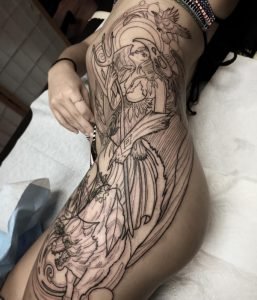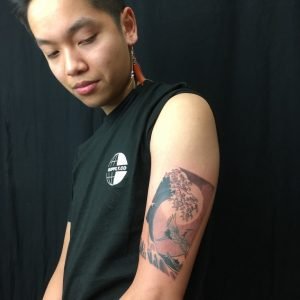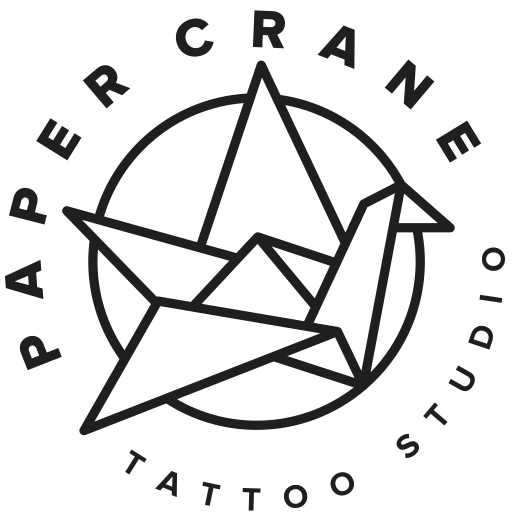How to Choose Your Tattoo Placement
For tattoo enthusiasts, the body is the ultimate canvas. At Paper Crane, we consider it an honor to permanently paint our clients with custom works of art. But the human skin differs in a very critical way from traditional canvases: Whereas you can hide a painting behind closed doors or tuck it away in a closet, your skin goes with you wherever you go. It's important of course to love your new tattoo design—but it's equally important to get it somewhere that you'll thoroughly enjoy! That's why we're breaking tattoo placement down into a few easy steps on today's blog.
Step 1: Decide how visible you want your new tattoo to be.
We live in an era where tattoos are more and more common, both in the US and across the world. Hand tattoos are still referred to as “job killers” by many tattoo professionals—but a cute little bow on your ring finger is less likely to be a hindrance to employment than it was once. Brides with full sleeves, lawyers with neck tattoos, models with chest pieces—although not everyone likes them, visible tattoos just aren't particularly uncommon or unusual.That said, there are many reasons to think about how visible you want your ink to be when deciding on tattoo placement:
- Personal Importance
- A tattoo is a lifetime commitment. (Yes, tattoo removal has come a long way, but you can't always completely remove a piece—and it's a big expense on top of the cost of the original tattoo.) It's our hope that you'll always love your ink, wherever you get it placed!
- But we suggest considering the subject matter when thinking about visibility. A tattoo of something personal like your grandfather's pocketwatch or your favorite dog will always carry sentimental value, so it's probably a safe bet that you won't mind showing it off or seeing it on a regular basis. Similarly, a tattoo that's symbolic of a major life event or a fandom you've loved for years will likely always be important to you.
- Certain tattoo subjects don't necessarily hold their value as well, though, or they're simply not all that meaningful to begin with. We're not saying every tattoo has to be serious! We love tattooing things that are fun, weird, hilarious, etc. But if you're getting a tattoo of a llama just because you think llamas are cute (which they totally are), you might consider a tattoo placement somewhere less front-and-center than a piece that has a more personal meaning.
- The same goes for tattoos connected to passing interests. If you're a die-hard Game of Thrones fan, go for the dragon sleeve! But if you're not sure you'll always be devoted to House Targaryen, you might want to go for a tattoo placement that isn't as readily visible or as large.
- Appropriateness
- Real talk: People get tattoos that are explicit in nature, whether that means a curse word, a zombie orgy, or a flying tampon.
- We have zero judgment and love getting creative with your ideas, so feel free to bring us your designs without feeling they're too “out there.”
- That said, it's important to think about your day-to-day life if you're getting something that might be considered inappropriate. Are you an adjunct professor at a conservative university? Are you heavily involved in charity work in your local community? Are you around other people's kids in a professional capacity?
- Ultimately, it's your body and your call: We trust you to know what works for you in the real world and what doesn't. (And if you're cool with wearing long sleeves to your day job, we're cool with tattooing that naked clown doing hot yoga on your forearm.)
- Employment and Career Goals
- While we agree that tattoos should not limit your career options, the fact is, they do. While some jobs might just want you to keep your art appropriate (sorry, naked yoga clown!), other employers have strict rules when it comes to tattoo placement.
- Despite the popularity of finger tattoos, full hand tattoos can still result in discrimination in the workplace. The same goes double for face and neck tattoos: As misinformed, out of line, and ignorant as they might be, people will judge you.
- If you're involved in an industry like tattooing or if you're a successful entrepreneur, then you don't have to worry as much about mundane things like whether or not an employer cares about that rose on your neck. But if not, we would encourage you to consider if the placement of your tattoo is going to interfere both with your basic needs (like food and shelter) and your ultimate career goals.
Step 2: Consider where on your body your design will look the best.
Our artists are among the best in the industry. When we work on your tattoo design, we take into account the unique flow of your body so that your custom piece will fit exactly right.
- Some tattoos look great no matter where you place them. Take flowers, for example: A few classic roses can flatter a shoulder blade, an elegant spray of orchids can look gorgeous on your calf, and a cherry blossom branch can perfectly fit the curve of your waist.
- Other tattoos work better in specific areas. A string of rosary beads wrapped around your wrist or ankle may look better than when tattooed flat across your bicep. Tribal designs likewise often look best when wrapped around a body part.
- Often, size and complexity play a key role in tattoo placement: A detailed portrait tattoo will read well on a flat expanse of skin like your back, whereas it might look warped or smushed on your ankle. A dainty moon, on the other hand, can be perfectly at home on even the most delicate of wrists.
- Composition is also important to consider. Take a look at this Hanafuda card Mikey recently did, which is perfectly suited to this clients arm thanks to the shape and the angle of the piece:

- Your personal build is also a factor, and it's something our artists carefully account for during design. If you have thick thighs or curvy hips, a tattoo that takes full advantage of your proportions can look significantly better than a tattoo that that leaves a lot of blank skin. If you have extremely narrow arms but want an expansive sleeve, you might be better served to have the design placed on your side.
Step 3: Balance your tattoo placement with your existing (or planned!) art.
- Is this your first tattoo? Your fifteenth?
- Is this the start of a sleeve or a stand-alone piece?
- Is the design for a statement tattoo or more of a filler?
You might not have answers to all of these questions—and that's okay! We love approaching tattoos organically or with a master vision. Whether we're adding on to a leg sleeve according to a thematic plan or expanding your tattoo collection as your ideas come, we're here to make your art look amazing.One question we get a lot is how to balance tattoo placement. Sometimes a client wants to achieve a balanced overall look with their current tattoos: This might mean putting a design on the left forearm to provide balance to a tattoo on the client's right hip. Other times, a client wants a single piece to have a sense of balance: With a sleeve tattoo of a wildlife scene done in an illustrative style, this might mean having two or three central focal elements, whereas an American Traditional sleeve might incorporate numerous small designs with fillers in between to give a “finished” feel.As always, personal preference is the key to balance. Is symmetry important to you, or do you want your tattoos all on one side? Do you like the cohesive look of a large-scale piece that's been thoroughly planned, or do you prefer different pieces coming together one at a time? Do you like having a number of tattoos all over, or would you prefer them grouped together in one or two places?We encourage you to check out our artist portfolios and social media to see what looks appeal to you, but remember that “balance” is a very subjective term—and we want to help you find your balance. That said, we'll definitely use our industry experience and artistic perspective to advise you on placement so that your tattoo(s) look intentional.Once upon a time, we might have included a Step 4 suggesting you take your pain tolerance into account—but at Paper Crane, we're pleased to offer HUSH anesthetics, which make any tattoo placement a possibility. These high-end gels and sprays can numb you to the pain of your tattooing session—so even if you have a low tolerance for pain, you can still get that wrist or rib tattoo you've been half-dreading, half-dreaming about.If you've got more questions about tattoo placement, we're always here to help! And again, we'd love for you to check out our portfolios and follow us on Instagram/Facebook to get ideas about where you might like your next tattoo. When you're ready to take the next step, schedule a consultation with one of our talented artists. We can't wait to help you decide where to place your new tattoo!

